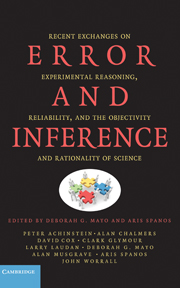 Error and Inference
Error and Inference Book contents
- Frontmatter
- Contents
- List of Contributors
- Preface
- Introduction and Background
- 1 Learning from Error, Severe Testing, and the Growth of Theoretical Knowledge
- 2 The Life of Theory in the New Experimentalism
- 3 Revisiting Critical Rationalism
- 4 Theory Confirmation and Novel Evidence
- 5 Induction and Severe Testing
- 6 Theory Testing in Economics and the Error-Statistical Perspective
- 7 New Perspectives on (Some Old) Problems of Frequentist Statistics
- 8 Causal Modeling, Explanation and Severe Testing
- 9 Error and Legal Epistemology
- Index
- References
6 - Theory Testing in Economics and the Error-Statistical Perspective
Published online by Cambridge University Press: 29 January 2010
- Frontmatter
- Contents
- List of Contributors
- Preface
- Introduction and Background
- 1 Learning from Error, Severe Testing, and the Growth of Theoretical Knowledge
- 2 The Life of Theory in the New Experimentalism
- 3 Revisiting Critical Rationalism
- 4 Theory Confirmation and Novel Evidence
- 5 Induction and Severe Testing
- 6 Theory Testing in Economics and the Error-Statistical Perspective
- 7 New Perspectives on (Some Old) Problems of Frequentist Statistics
- 8 Causal Modeling, Explanation and Severe Testing
- 9 Error and Legal Epistemology
- Index
- References
Summary
Introduction
For a domain of inquiry to live up to standards of scientific objectivity it is generally required that its theories be tested against empirical data. The central philosophical and methodological problems of economics may be traced to the unique character of both economic theory and its nonexperimental (observational) data. Alternative ways of dealing with these problems are reflected in rival methodologies of economics. My goal here is not to promote any one such methodology at the expense of its rivals so much as to set the stage for understanding and making progress on certain crucial conundrums in the methodology and philosophy of economics. This goal, I maintain, requires an understanding of the changing roles of theory and data in the development of economic thought alongside the shifting philosophies of science, which explicitly or implicitly find their way into economic theorizing and econometric practice. Given that this requires both economists and philosophers of science to stand outside their usual practice and reflect on their own assumptions, it is not surprising that this goal has been rather elusive.
The Preeminence of Theory in Economic Modeling
Historically, theory has generally held the preeminent role in economics, and data have been given the subordinate role of “quantifying theories” presumed to be true. In this conception, whether in the classical (nineteenth-century) or neoclassical (twentieth-century) historical period or even in contemporary textbook econometrics, data do not so much test as allow instantiating theories: sophisticated econometric methods enable elaborate ways “to beat data into line” (as Kuhn would say) to accord with an assumed theory.
- Type
- Chapter
- Information
- Error and InferenceRecent Exchanges on Experimental Reasoning, Reliability, and the Objectivity and Rationality of Science, pp. 202 - 246Publisher: Cambridge University PressPrint publication year: 2009
References
- 26
- Cited by


